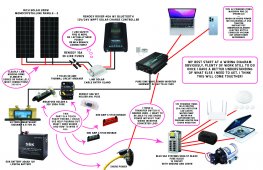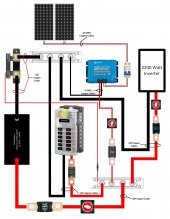TravelingSLO
New Member
- Joined
- Jul 12, 2022
- Messages
- 17
Hello, Kim here! Brevity isn't my strong point - so I apologize in advance for what will probably read like an overly long novel. Also, the thing I care most about is safety. Fire scares the shit out of me, and I don't want to burn my wee house down. Also, someone suggested revising this post, so here we go:

I am confused about the following:
I have a Riverside Retro 189R travel trailer; purchased new in 2020; it currently runs 12V DC from a DieHard Silver Marine/RV Deep Cycle battery and 110V AC on a 30amp setup when connected to shore power - it has a port for Zamp Solar panels, but I assume it's basically a BS thing, as it's halfway down the side of the rig, and the last thing that said it was "pre-wired for a backup camera" meant "we drilled a hole in the aluminum for you, get some tweezers and grab the wires and figure out how to wire it yourself lady." We'd like to be doing a LOT more boondocking than we have been doing, but we need to have a more stable battery setup to do this. Also, when it's parked and we are in a house, I'd like the solar panels to keep the battery charged.
I am installing a solar setup + LiFePO4 206Ah battery following Will's basic DIY 400 Watt 12 volt Solar Power System - I have watched the videos, read the book, but I still have questions. I have also referenced a number of other YouTube videos and the Asobo Camper Van Solar Build website and free e-books on the topic. I discussed options with Dexter at Current Connected, whom I obtained some of my system components from (I recommend them - he's super helpful and friendly!) I've done an energy audit to the best of my ability, and we are also happy to conserve to meet the needs of this system - the most important thing that runs is a Wi-Fi router which we had converted to DC (on the second try - first tech caught the wires on fire and melted it before giving up).
While I completely new at this, I can follow written instructions, and my best friend has a CS/EE degree and is very handy with electrical wiring, so I believe I can actually accomplish this mostly on my own with his help (I've had crappy luck trying to hire someone to do RV repairs unfortunately, so I think I will actually care more than the three techs we've used thus far - and therefore do a possibly better job at this solar thing.)
I've tried to refer to threads on here, such as this one, but I'm not always clear on if they apply to my situation, hence this long post.
The components I've bought are:
Still need to buy:
 Thanks you for reading and thanks for any help you're willing to provide. I'll happily bake anyone cookies in my adorable wee oven - once I get this thing working again - and deliver them if you'll help me.
Thanks you for reading and thanks for any help you're willing to provide. I'll happily bake anyone cookies in my adorable wee oven - once I get this thing working again - and deliver them if you'll help me.

I am confused about the following:
- Is this the worst idea I've ever had? We take long trips - like months at a time - and the current battery setup sucks. And requires us to regularly find shore power, or run an extension cord from the inverter in our truck through the window to our dinette so Eric can charge his laptop for work. Honestly, we could live without most of the RV stuff for days on end, but the Wi-Fi, laptop, and phone charging is required for work.
- Series or Parallel - I will be facing shady situations, so I am thinking parallel might make more sense. I've tried to understand series vs. parallel, but I am not winning at this - can someone just tell me which one to pick? I only have two panels, they match, and there will probably be shade in my future.
- Do I remove the existing "electricity brain" in the RV? It has a WFCO 8900 series Power Center currently installed. Is the idea with this new build and selection of products that I basically gut all the stuff in there and replace it with the new equipment? I haven't seen this mentioned clearly in any of the dozens of videos I've watched, but it seems like I am replacing the existing unit with better individual components which will allow the lithium battery to be charged and all of the AC/DC devices to be used.
- Do I need a shutoff or transfer switch or something to disconnect the various parts? If so, can you tell me which item and where it goes?
- Wire. Oh my, wire. I have read the Victron Wire Guide and am still somewhat confused. I know I need thick large gauge wire for the battery situation, and a smaller gauge for everything else, but I am wondering should I go with larger wire than required for safety? What's the best choice here? Also, I need black wire and red wire, and what about a grounding wire? I assume there is a ground attached to the current WFCO Power Center, can I use that one?
- The fuse/breaker situation - there's fuses everywhere, and a breaker, and also, maybe I don't have the right types/sizes/etc. I ordered two fuses which I think might be to small, and then I also ordered a circuit breaker which might be too large. I tried to read up on here, and it seems like folks often recommend the Class T fuse; I am happy to order one, but which one exactly? And where exactly does it go?
- Some folks on here really hate on the Renlogy stuff - and I have a Renogy 40A 12V/24V Auto DC Input MPPT Solar Charge Controller w/ Bluetooth. If this is the biggest mistake I am making, tell me now so I can return it.
I have a Riverside Retro 189R travel trailer; purchased new in 2020; it currently runs 12V DC from a DieHard Silver Marine/RV Deep Cycle battery and 110V AC on a 30amp setup when connected to shore power - it has a port for Zamp Solar panels, but I assume it's basically a BS thing, as it's halfway down the side of the rig, and the last thing that said it was "pre-wired for a backup camera" meant "we drilled a hole in the aluminum for you, get some tweezers and grab the wires and figure out how to wire it yourself lady." We'd like to be doing a LOT more boondocking than we have been doing, but we need to have a more stable battery setup to do this. Also, when it's parked and we are in a house, I'd like the solar panels to keep the battery charged.
I am installing a solar setup + LiFePO4 206Ah battery following Will's basic DIY 400 Watt 12 volt Solar Power System - I have watched the videos, read the book, but I still have questions. I have also referenced a number of other YouTube videos and the Asobo Camper Van Solar Build website and free e-books on the topic. I discussed options with Dexter at Current Connected, whom I obtained some of my system components from (I recommend them - he's super helpful and friendly!) I've done an energy audit to the best of my ability, and we are also happy to conserve to meet the needs of this system - the most important thing that runs is a Wi-Fi router which we had converted to DC (on the second try - first tech caught the wires on fire and melted it before giving up).
While I completely new at this, I can follow written instructions, and my best friend has a CS/EE degree and is very handy with electrical wiring, so I believe I can actually accomplish this mostly on my own with his help (I've had crappy luck trying to hire someone to do RV repairs unfortunately, so I think I will actually care more than the three techs we've used thus far - and therefore do a possibly better job at this solar thing.)
I've tried to refer to threads on here, such as this one, but I'm not always clear on if they apply to my situation, hence this long post.
The components I've bought are:
- 2 - 200W Rich Solar Monocrystalline Panels
- Victron | SmartShunt | 1000A | 6.5-70vDC
- Renogy 40A 12V/24V Auto DC Input MPPT Solar Charge Controller w/ Bluetooth
- MegaFuse Holder + 2 Fuses for Inverter
- 2 - (Red & Black) 4 Stud Bus Bar Power Distribution Block with Cover
- Large fuse for the MPPT/Renogy 40A Set w Holder ANL Fuse
- T Tocas 50 Amp Thermal Circuit Breaker with Switch Manual Reset for Boat Marine RV Yacht Battery Truck Solar, 12V - 48V DC, Waterproof (50A)
- 1 - SOK Battery | 206Ah 12v | LiFePO4 Battery | Solar Battery - Welded / Powder-Coated Metal
- Giandel Pure Sine Wave Power Inverter 2200Watt
- Cable Entry Gland (I bought two accidentally - so there is the BougeRV and the Link Solar)
- Blue Sea Systems 5026 Blue Sea Systems ST Blade Fuse Block 12 Circuit with Ground and Cover
- Renogy 15A Male and Female Connector Waterproof in-Line Fuse Holder w/Fuse, Black
- Crimp Connectors/ELECFUN 56pcs Battery Cable Ends 8-4 AWG Heavy Duty Wire Lugs Tinned Copper Eyelets Battery Cable Ends
- Crimp Connectors/Wirefy Heat Shrink Wire Connectors Kit - Marine Grade Electrical Connectors
- Litorange 325Pcs Rubber Grommet Eyelet Ring Gasket Assortment - 1/4", 5/16", 3/8", 7/16", 1/2", 5/8", 7/8", 1" for Automotive, Wire, Plug and Cable (to protect the cables going into the aluminum - recommended by the couple at Asobo, and made sense based on my install of the backup camera)
- BNTECHGO 10 Gauge Flexible 2 Conductor Parallel Silicone Wire Spool Red Black High Resistant 200 deg C 600V for Single Color LED Strip Extension Cable Cord,Model,50ft Stranded Copper Wire (does this wire suck? Someone on either here or another site recommended this specific wire, and I can't seem to find any locally, although I have a new lead)
Still need to buy:
- Z-brackets for mounting solar panels
- Solar panel extension wires w/ MC-4 and inline fuses
- Branch Connectors
- Wire Crimping Device (looking at this one from Harbor Freight)
- Wire
- Lap Sealant
- Probably a thousand other things you will hopefully inform me of?
Last edited:




